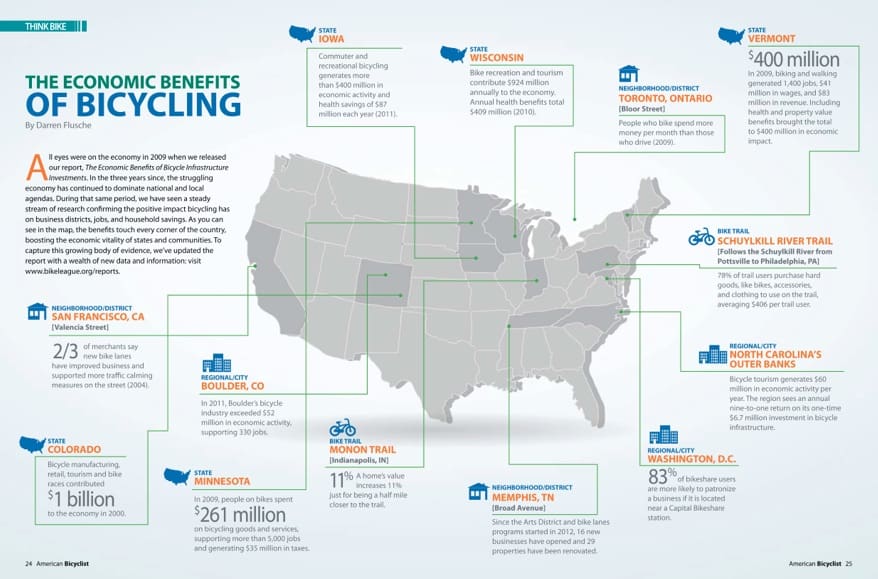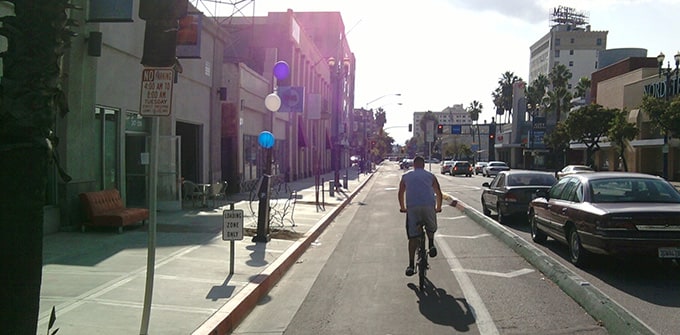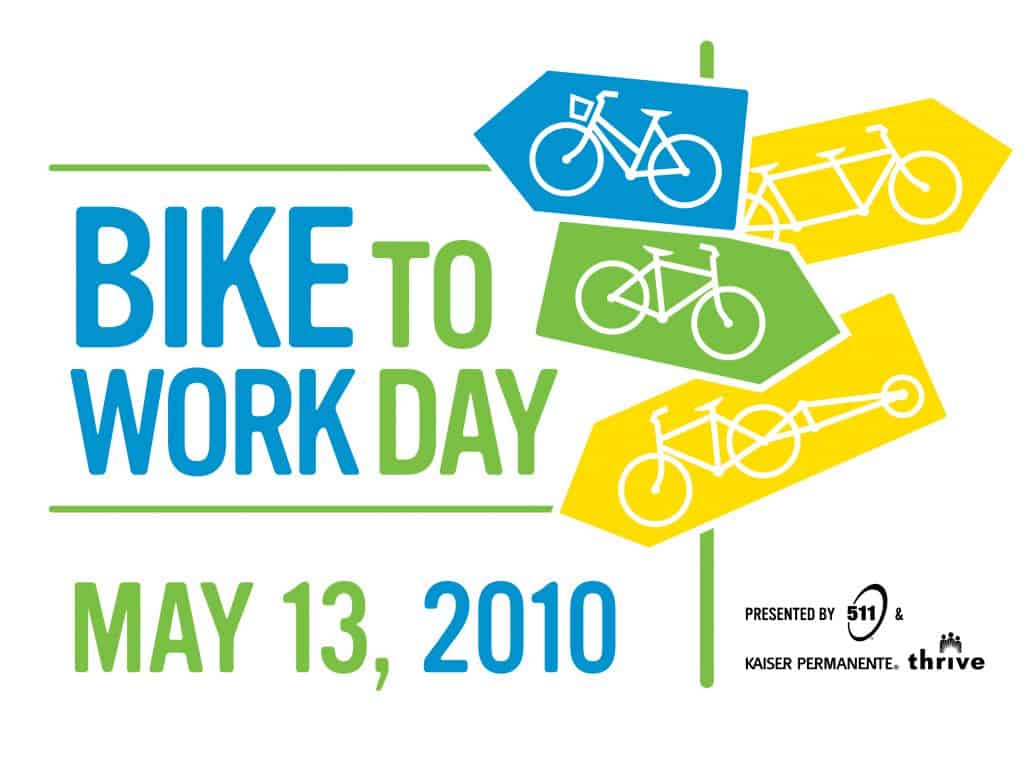
Good for business? A former parking space for a single car now easily accommodates 10 times as many bicycles.
Photo credit: Walk Eagle Rock
Here at 511 Contra Costa we tag posts that directly or indirectly feature the benefits of bicycling with our “bike benefits” tag. Of the many benefits we’ve covered, one is increasingly being spotlighted by city officials and advocates alike– the economic benefits of bicycling and bicycle infrastructure. It is perhaps little surprise that the League of American Bicyclists put together a graphic outlining the studies conducted across the nation that have demonstrated bicycling provides economic benefits.

From coast to coast, bikes mean business! Image via: Co.Exist
Among the studies highlighted in the graphic is one from the Bay Area in San Francisco, which showed 66% of merchants along Valencia Street reporting improved business following the implementation of bike lanes on the street. Intuitively, this finding makes a lot of sense because bike lanes typically lead to an increase in the number of people cycling on the street, and over 300 parked bicycles can fit in the same amount of space it takes to accommodate 30 parked cars. With space for automobile parking being a concern among retailers, it seems more efficient and economically sound to have as many customers arrive by bicycle rather than car as possible (And not to mention that by bicycling people save money on gas and parking and therefore have more money to spend at local businesses).
Since the League of American Bicyclists put together this graphic, and the accompanying report on the economic benefits of bicycle infrastructure, additional studies continue to echo these findings. In New York, a study conducted by the Department of Transportation found businesses on 9th Avenue in Manhattan reporting almost a 50% increase in sales after a protected bike lane was installed on the street. Even in Los Angeles, one case-study found that the re-configuring of one commercial street to include bike lanes did not hurt businesses despite fear among merchants that it would.
As more studies emerge be sure to keep an eye on our “bike buck$” tag for more posts on the economic benefits of bicycling.
Tag: Bike Buck$
Portland Cycling

Look at Portland’s impressive, dedicated bicycle infrastructure. Photo credit: Greg Raisman
USA Today recently took an in-depth look at the state of bicycling in Portland, Oregon in an article titled “In Portland, Ore., Bikes Rule the Road“. Many points made in the article were eye-opening and worth highlighting.
The article begins:
America spent 50 years and billions of dollars after World War II redesigning itself so that cars could move people across this vast country more quickly.
Now, with many cities in gridlock, one-third of the population obese and climate change forcing innovators to look beyond the internal combustion engine, cities are beginning to rethink that push toward the automobile.
Perhaps no place has thought about it more than Portland, rated America’s most bike-friendly city this year by Bicycling magazine

Portland bike traffic. Photo credit: Dave Feucht
Nationally 13% of children walk or cycle to school, according to the National Household Travel Survey whereas in Portland 31% of children walk or cycle to school!

Children cycling in Portland. Photo credit: Greg Raisman
The article also notes that Portland is constantly being visited by transportation officials from around the nation (and world) to learn how to increase bicycle mode-share:
Indeed, groups arrive almost weekly to pedal the streets and hear from city staff how Portland has accomplished what no other major U.S. city has: getting people out of their cars and onto the bike paths coursing through this hilly metropolis. (This summer alone, groups from Seattle, San Francisco, Philadelphia, New York City, Washington, D.C., Holland, Japan and South Korea made the trek.)
While Portland continues to expand bicycling with each year, it should be understood that Portland isn’t steering towards a bike-only environment. As Jennifer Dill, director of the Oregon Transportation Research and Education Consortium at Portland State University comments in the article:
In many cities you have no choice — you have to drive to work. Here, you have a choice. What we’ve found is that given an array of choices — driving, taking the bus, biking or walking — a lot of people will choose other options than driving
However, becoming a bike friendly city takes time. World renowned bicycle researcher at Rutgers University, John Pucher notes, “You don’t all of a sudden put in 500 miles of bike lanes.”
It took Portland 20 years to get where it is now, and while a lot of bicycle infrastructure has been built during that time, Portland’s bike network was surprisingly cheap to build. How cheap? Try the cost of a single mile of urban four-lane freeway– roughly $60 million.
Read the full story (and view the attached video) over at USA Today.
Long Beach's Bicycle Friendly Business Program

Protected bike lane in downtown Long Beach that physically separates cyclists from motorists. Photo credit: Joe Linton/Streetsblog
Long Beach is at it again! When it isn’t installing Southern California’s first protected bike lane or attempting to launch one of the largest bike-share systems in the United States, the LA beach city has also quietly been a leader in encouraging people to cycle with their Bicycle Friendly Business District Program.
A first in the nation, the program was funded by a Los Angeles County Department of Public Health grant and is an excellent way to incentivize making trips to local restaurants and shops by bike. The program is also a great way to rediscover the magic of the city, according to Long Beach mayor Bob Foster:
Bicycling encourages shopping and dining locally. As Long Beach Mayor Bob Foster explains, it also introduces people to businesses we may not notice while speeding by in a car: “I see parts of the city on my bike that I would never even notice if I was just driving. And I love it. It’s not only great exercise, it’s a way for me personally to get closer to the city.” Increased bicycling and decreased driving in business districts also reduces traffic and parking issues.

This innovative piece of bicycle infrastructure in one of Long Beach’s shopping districts is known as a super sharrow. Photo credit: San Francisco Bicycle Coaltion
So far the program has been a huge success, watch this video and see for yourself!
Perhaps this is something Contra Costa cities can do to encourage people cycle and shop locally. What do you think?
Read more about Long Beach’s Bicycle Friendly Business District over at Momentum Magazine or at Bike Long Beach
Turning 30 Car Parking Spaces Into 300+ Bike Parking Spaces

Eight bicycles fill this bicycle corral using space which would otherwise accommodate one motor vehicle. Photo credit: San Francisco Bicycle Coalition
San Francisco is undoubtedly setting the bar high for fellow Bay Area cities looking to become more bike friendly, spearheading innovative infrastructure treatment like painting bike lanes green and creating protected bike lanes. However, the city has also been moving ahead with a more subtle change to embrace cycling– since San Francisco started implementing it’s Bike Plan in mid-2010 the city has converted 30 curbside car parking spaces into over 300 bike parking spaces!
336 bike parking spaces to be precise, according to SF Streetsblog who originally covered this impressive milestone. In a city as densely packed as San Francisco, this move maximizes efficiency of existing space and provides more parking near local businesses. As bicycling continues to grow in the Bay Area, perhaps more cities will turn to on-street bike parking as an inexpensive and effective solution to meet parking demand.
What's A Bicyclist's MPG?
It seems not a day goes by without hearing which cars on the market have the best mileage, and how efficient electric and hybrid vehicles of the future will be. But what about the world’s most efficient vehicle, the humble bicycle? Some like to joke that bicyclists run on burritos or other quick eats instead of gasoline– but is it possible to calculate some sort of miles per gallon (MPG) equivalent for the bipedal bunch powered by food?

How many miles per gallon is she getting? Photo credit: Richard Masoner
Do the Math recently tackled the task and arrived at a surprising figure– apparently a person riding a bicycle gets the equivalent of 290miles per gallon riding around town, and 190 miles per gallon on the open road. Not bad for a vehicle over a hundred years old, right? And if humans were as aerodynamic as trout, that MPG would be even higher!
If you have the time, or consider yourself a math whiz, the full article is well worth a read.
Saving Money by Pedaling Miles
We hear plenty of the environmental and health benefits of cycling from individuals and cities that have embraced two-wheels, and understandably so, the bicycle is an impressive tool (in fact, it is the most efficient vehicle man has invented). But a benefit we hear less often about when talking bicycles is the monetary one. However, given the price of motoring and a struggling economy maybe this should change…

Bicycling in San Francisco. Photo credit: San Francisco Bicycle Coalition
A new report has found that American cyclists save a collective 4.6 billion dollars by avoiding driving.
Other significant findings include:
- The average annual operating cost of a bicycle is $308 — versus $8,220 for the average car.
- If American drivers replaced just one four-mile car trip with a bike each week for the whole year, it would save more than 2 billion gallons of gas. At $4 per gallon, total savings would be $7.3 billion a year
-
For $60 million—the cost of a single mile of urban highway—the new city-wide bicycle network earned Portland, OR, the highest possible platinum rating as a Bicycle Friendly Community.
The report states the case that cities and individuals alike can help reduce economic struggle by bicycling. Head over to treehugger for the full article or click here to download the full .pdf report.
Happy Bike to Work Day!

From everyone at 511CC, we wish you a happy and safe day as you bike your way to and from work or school.
But there’s more! The Bike to Work Day celebration doesn’t quite stop after the end of the day today:
- From 4-6:30 pm, 511CC is hosting an Evening on the Trails. Check our Bike to Work Day page for more information.
- Submit your photos and/or videos of Bike to Work Day to enter for a chance to win $25 Peet’s Coffee & Tea! Submissions must be sent by May 14, 2010 at 5pm PST to be eligible for the prize drawing. Enter by tagging your tweets with #btwd511cc or email them to: bike@511contracosta.org.
- Earn Bike Buck$ with 511CC by riding your bike to work through the month of May.
- On our Bike to Work Day page, leave a comment about your experience with the event.
